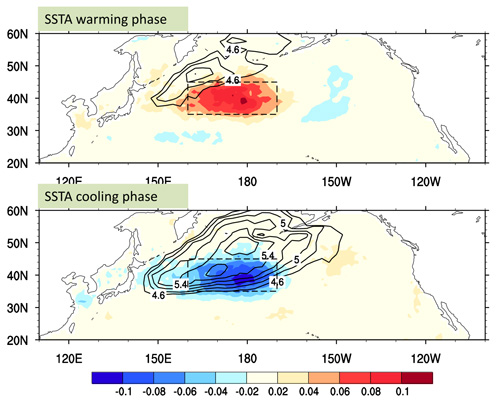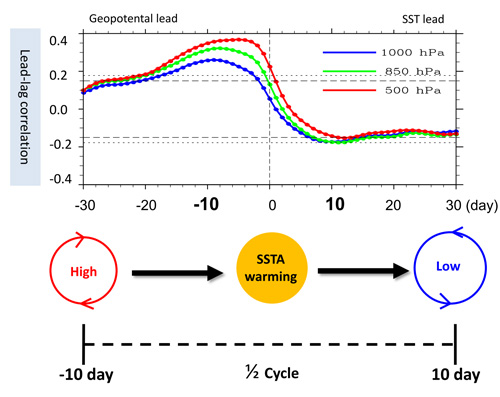Collaborated Research from IAP and UH Explains the Mechanisms for the Intraseasonal Variability over North Pacific
Date:2015-09-06
As mid-latitude North Pacific is located to the east of East Asia and to the west of North America, the variation of the atmosphere and ocean over it plays an essential role in the variability of circulation, temperature and precipitation over the two continents. Therefore, understanding the mechanism of the circulation variations over mid-latitude North Pacific will benefit the forecasts for weather or climate anomalies over the upstream and downstream continents. Previous studies have shown that there are strong intraseasonal signals in the atmosphere and sea surface temperature (SST) in this region, which, however, has not been understand well; whether the signals are originated from the tropical area are debatable.

Fig. 1 Magnitude of surface high-frequency wind (contours) and SST tendency (shading) for SST warming phase and SST cooling phase (Wang et al, 2015).
Concentrating on this issue, Dr. WANG Lu from Institute of Atmospheric Physics (IAP), who received her PhD degree in 2012 in IAP and now is a Post-doctoral fellow in University of Hawaii (UH), Prof. LI Tim from UH and Dr. ZHOU Tianjun from IAP conducted a series of research. It is found that 1) the intraseasonal SST oscillation (20-100 day) can be attributed to the intraseasonal variation of the low-level circulation and surface high-frequency disturbances (<20 day) (the latter process could explain up to 20% of the SST amplitude shown by OGCM experiments)– SST warming is accompanied by anomalous anti-cyclonic circulation and weak high-frequency wind while the SST cooling is accompanied by anomalous cyclonic circulation and strong high-frequency wind; the warm SST can help the transition of the atmospheric circulation from anti-cyclonic cell to cyclonic cell through triggering the atmospheric convective instability. The whole evolution takes about 40 days which implies that such air-sea feedback process could help triggering the intraseasonal signal in the mid-latitude atmosphere. 2) The dominant mode of the intraseasonal signals at the upper troposphere is westward moving Rossby wave, and its development and strengthening is related to the upscale feedback of high-frequency disturbances and the barotropic energy transition. 3) The impact of the tropical forcing on the mid-latitude intraseasonal oscillation is about 20%.

Fig. 2 Schematic diagram for the intraseasonal variation of the air-sea system (The upper panel, Wang et al 2012; the schematic diagram was plotted by WANG Lu).
The above studies have been published on Journal of Climate and Climate Dynamics in 2012, 2013 and 2015. These findings are significant for understanding the mechanisms of the low-frequency variations of the mid-latitude atmosphere.
Citation:
1.Wang, L., T. Li and T. Zhou, 2015: Effect of High-frequency Wind on Intraseasonal SST Variabilities over the Mid-latitude North Pacific Region during Boreal Summer. Climate Dynamics, DOI: 10.1007/s00382-015-2496-2
Download: http://link.springer.com/article/10.1007/s00382-015-2496-2
2. Wang, L., T. Li, T. Zhou and X. Rong, 2013: Origin of the Intraseasonal Variability over the North Pacific in Boreal Summer. Journal of Climate, 26, 1211-1229.
Download: http://journals.ametsoc.org/doi/abs/10.1175/JCLI-D-11-00704.1
3. Wang, L., T. Li and T. Zhou, 2012: Intraseasonal SST Variability and Air–Sea Interaction over the Kuroshio Extension Region during Boreal Summer. Journal of Climate, 25, 1619-1634.
Download: http://journals.ametsoc.org/doi/abs/10.1175/JCLI-D-11-00109.1
Contact: Dr. Wang Lu, wanglu2007@mail.iap.ac.cn
